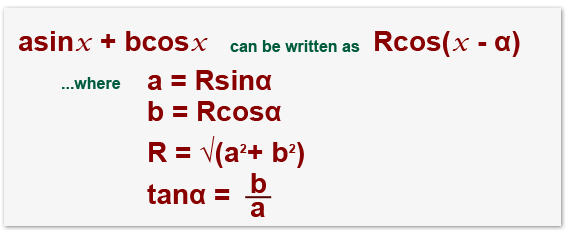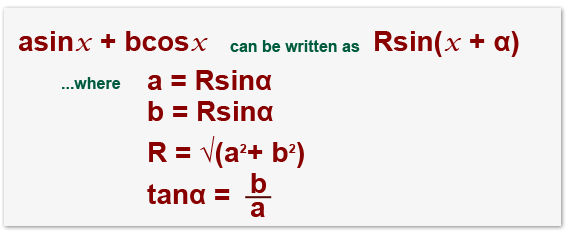R-Alpha Method
It is quite difficult since the function is the sum of two functions 3sinx and 4cosx.
Rcos(x – α)
We have to compare these two functions to find R and α. First let’s expand y=Rcos(x- α) using the addition formulae.
Now we compare the two expressions to find the R and α as shown in the following;
Notice we have to have the RHS matched with the LHS. So we rewrite the RHS to match.
Be careful here look at what has changed carefully especially the position of the terms in the RHS expression. It’s very important that you understand this because if you don’t you will always fail or get the wrong outcome. It’s very common in students to fail this.
Now we compare each part
So we have found that;
To find α we have to divide equation 1 by equation 2 as follows;
Dividing R by R is one so we take that out;
Sine divided by Cosine is equal to tangent so;
To find R we must add equation 1 to equation 2 in this format;
…simplify;
…we know that sin2α + cos2 α is 1 so;
The function of y = 3sinx + 4cosx when rewritten in Rcos(x- α) becomes;
We have managed to find a simpler function which will enable us to sketch the graph easily;
[graph id=”28″]
…from this we get;
We divide equation 1 by equation 2 to get α as shown below;
To find R we add the equations in the form of;
So now we have;
We have managed to rewrite sinx + cosx as √2cos(x-45°).
Rsin(x + α)
We can also write two functions as Rsin(x+ α).
Then we compare the two functions as follows;
We rewrite the RHS so that they match with LHS as follows. Take care…
Now we take out the two equations we are after as we did before;
To find α we must divide equation 2 by equation 1 as shown below;
We have now found α we need to find R by adding equation 1 plus equation 2 as we did before;
Now we replace the found values into Rsin(x+ α) as follows;
We have managed to rewrite 3sinx + 2cosx as √13sin(x+33.7°). With this now it’s more easy to draw the graph as shown below;
[GRAPH]
So now let’s summarise the alpha methods below;
The above are the alpha methods.
It would be impossible to solve an equation such as sinx + cosx = 1 because there is no identity to support. The following example shows how to solve equations using the alpha methods.
Solve equations
We have to decide which R-alpha method/formula to use to rewrite 4sinx + 6cosx. We have Rcos(x- α) or Rsin(x+ α) Let’s use Rcos(x- α). First we compare and match as we did above.
Notice above I haven’t shown the process of matching but you have to carry out this as it is important.
We have to find α by diving the equations we have found as shown below;
To find R we have to add the equations and finally get;
Now we replace the α value and R value we have found into Rcos(x- α) to get;
because;
Now we need to find the angles;
And also;
The solutions we have found are;


